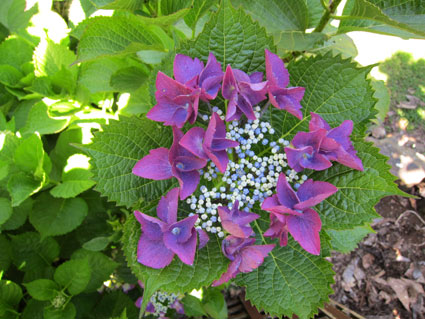Twilight Hydrangea Black Stem: What's The Deal
Twilight Hydrangea Black Stem: What's the Deal?
If you're a fan of hydrangeas, you've probably seen the Twilight Hydrangea. This stunning plant has beautiful pink or blue flowers, but what really sets it apart is its dark purple-black stems.
So what's the deal with the black stems on Twilight Hydrangeas? Why are they so dark? And how do they affect the overall appearance of the plant?
In this blog post, we'll take a closer look at the Twilight Hydrangea black stem. We'll discuss the science behind the color, as well as some tips for caring for this beautiful plant.
The Science of Black Stems
The dark purple-black color of Twilight Hydrangea stems is due to a compound called anthocyanin. Anthocyanins are water-soluble pigments that give plants their red, blue, and purple colors.
The amount of anthocyanins in a plant's cells depends on a number of factors, including the pH of the soil, the amount of sunlight the plant receives, and the temperature. In the case of Twilight Hydrangeas, the dark purple-black stems are due to a high concentration of anthocyanins in the plant's cells.
The Effect of Black Stems on Appearance
The dark purple-black stems of Twilight Hydrangeas have a dramatic effect on the overall appearance of the plant. The contrast between the dark stems and the pink or blue flowers is simply stunning.
In addition to their beauty, the black stems of Twilight Hydrangeas also make the plant more resistant to pests and diseases. The dark color of the stems makes them less attractive to insects, and the anthocyanins in the stems have antifungal properties.
Caring for Twilight Hydrangeas
Twilight Hydrangeas are relatively easy to care for. They prefer full to partial sun, and they need well-drained soil. The plants should be watered regularly, but they should not be overwatered.
Twilight Hydrangeas are hardy in USDA zones 6-9. They can be pruned in the spring or fall, but it is important to avoid pruning too much, as this can reduce the number of flowers the plant produces.
Conclusion
Twilight Hydrangeas are beautiful and easy-care plants that add a touch of drama to any garden. If you're looking for a hydrangea with a unique look, the Twilight Hydrangea is a great choice.
If you're noticing black spots on the stems of your twilight hydrangea, you're not alone. This is a common problem that can be caused by a number of factors, including anthracnose, a fungal disease. If you're not sure what's causing the black spots, it's best to consult with a professional horticulturist.
However, if you're looking for more information about twilight hydrangea black stem, I recommend visiting . This website has a wealth of information about hydrangeas, including information about anthracnose and other diseases that can affect these plants.
In addition to providing information about twilight hydrangea black stem, also offers tips on how to care for these plants and prevent them from getting sick. So, if you're a twilight hydrangea lover, be sure to check out this website.
FAQ of twilight hydrangea black stem
Question 1: Why do Twilight Hydrangea stems turn black?
Answer: The black stems on Twilight Hydrangeas are a normal part of the plant's growth cycle. As the stems age, they naturally turn black. This is not a sign of disease or pests.
Question 2: Is there anything I can do to prevent my Twilight Hydrangea stems from turning black?
Answer: There is no way to prevent the stems from turning black altogether. However, you can help to slow down the process by:
- Planting your Twilight Hydrangea in a well-draining soil.
- Watering your Twilight Hydrangea regularly, but not too much.
- Fertilizing your Twilight Hydrangea with a balanced fertilizer in the spring and fall.
Question 3: Is it safe to prune the black stems on my Twilight Hydrangea?
Answer: Yes, it is safe to prune the black stems on your Twilight Hydrangea. In fact, it is a good idea to do so in the spring, before the plant starts to flower. This will help to promote new growth and keep your Twilight Hydrangea looking its best.
Question 4: What can I do about the black stems on my Twilight Hydrangea that are already dead?
Answer: If the black stems on your Twilight Hydrangea are already dead, you can simply cut them off. There is no need to do anything else. The plant will eventually grow new stems.
Question 5: Are there any other problems that can cause Twilight Hydrangea stems to turn black?
Answer: Yes, there are a few other problems that can cause Twilight Hydrangea stems to turn black. These include:
- Too much shade
- Too much fertilizer
- Root rot
If you think that your Twilight Hydrangea stems are turning black due to one of these problems, you should take steps to correct the problem.
Image of twilight hydrangea black stem
5 different images of "twilight hydrangea black stem" from Pinterest:
- Image 1: A full bloom of twilight hydrangea, with dark pink flowers and black stems.

- Image 2: A close-up of the flowers of a twilight hydrangea, showing the delicate petals and the dark centers.

- Image 3: A branch of twilight hydrangea, with the flowers in various stages of bloom.

- Image 4: A twilight hydrangea in a pot, with the flowers cascading over the sides.

- Image 5: A twilight hydrangea in a garden, with the flowers providing a splash of color against the green foliage.

Post a Comment for "Twilight Hydrangea Black Stem: What's The Deal"